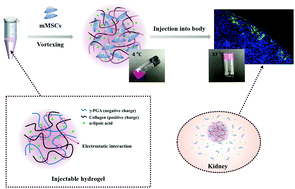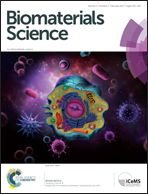An injectable collagen/poly(γ-glutamic acid) hydrogel as a scaffold of stem cells and α-lipoic acid for enhanced protection against renal dysfunction†
Abstract
Mesenchymal stem cells (MSCs) can ameliorate renal injury and accelerate repair of acute kidney injury. Herein, we developed a collagen/poly(γ-glutamic acid) (γ-PGA) hydrogel as an injectable scaffold for the delivery of mouse MSCs (mMSCs) and anti-oxidant drugs into injured sites. By the introduction of γ-PGA into conventional collagen, the viscosity of collagen was reduced at ambient temperature for easy handling, while the elastic and viscous moduli of collagen were increased and a new porous structure was generated near body temperature. When in situ gel-forming collagen/γ-PGA hydrogels loaded with mMSCs and α-lipoic acid (LA) were administered to a mouse model of renal dysfunction, they significantly attenuated the level of blood urea nitrogen and creatinine, which resulted from the increased retention of therapeutic mMSCs and the controlled release of anti-oxidant drugs at the injured site. These findings suggested that this novel type of hydrogel could be applied as an injectable scaffold for use in regenerative medicine.



 Please wait while we load your content...
Please wait while we load your content...